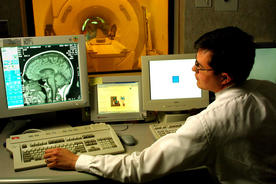Social Perceptions and Altruism Research
 Duke neuroscientist Scott Huettel, whose neuroeconomics work we described in Decision Making, Risk, and Ambiguity, is back in the news with some interesting work on the neuroscience of altruism.
Duke neuroscientist Scott Huettel, whose neuroeconomics work we described in Decision Making, Risk, and Ambiguity, is back in the news with some interesting work on the neuroscience of altruism.
Duke University Medical Center researchers have discovered that activation of a particular brain region predicts whether people tend to be selfish or altruistic.
“Although understanding the function of this brain region may not necessarily identify what drives people like Mother Theresa, it may give clues to the origins of important social behaviors like altruism,” said study investigator Scott A. Huettel, Ph.D., a neuroscientist at the Brain Imaging and Analysis Center… Altruism describes the tendency of people to act in ways that put the welfare of others ahead of their own. Why some people choose to act altruistically is unclear, says lead study investigator Dharol Tankersley, a graduate student in Huettel’s laboratory.
In the study, researchers scanned the brains of 45 people while they either played a computer game or watched the computer play the game on its own. In both cases, successful playing of the game earned money for a charity of the study participant’s choice…
The scans revealed that a region of the brain called the posterior superior temporal sulcus was activated to a greater degree when people perceived an action — that is, when they watched the computer play the game — than when they acted themselves, Tankersley said. This region, which lies in the top and back portion of the brain, is generally activated when the mind is trying to figure out social relationships… The fMRI scans showed that increased activity in the posterior superior temporal sulcus strongly predicted a person’s likelihood for altruistic behavior.
According to the researchers, the results suggest that altruistic behavior may originate from how people view the world rather than how they act in it. “We believe that the ability to perceive other people’s actions as meaningful is critical for altruism,” Tankersley said.
(From DukeMedNews.) While altruism may be far from the minds of most marketers, the findings may still have some relevance. Obviously, non-profit marketing appeals directly to the altruism of its targets, though I don’t expect the United Way to sign up for expensive brain scan market research in the immediate future. Still, it would be interesting to replicate Huettel’s study with the subjects viewing charity advertisements rather than a computer game. Would images of, say, Red Cross volunteers helping hurricane victims light up the posterior superior temporal sulcus in some viewers? And, if so, could one use that information to compare several different ads or marketing approaches? Presumably, the ads that produced the highest activation levels in the largest percentage of subjects would be more effective.
Mainstream marketers might benefit from this work, too, although that’s speculation right now. Tankersley’s comment about being able to measure “the ability to perceive other people’s actions as meaningful” leads one to extrapolate to non-altruistic settings. Prescription drug ads often feature actors playing credible-looking doctors or other spokesperson roles interacting with other actors; financial services ads similarly may show presumed financial planning experts helping clients achieve life goals. Would some ads that resonate more with viewers (who can better identify with the social interaction occurring in the ad) cause higher levels of activation in the same area of the brain now associated with altruism? This would certainly be something to look for in the privately funded ad studies underway in many labs.
